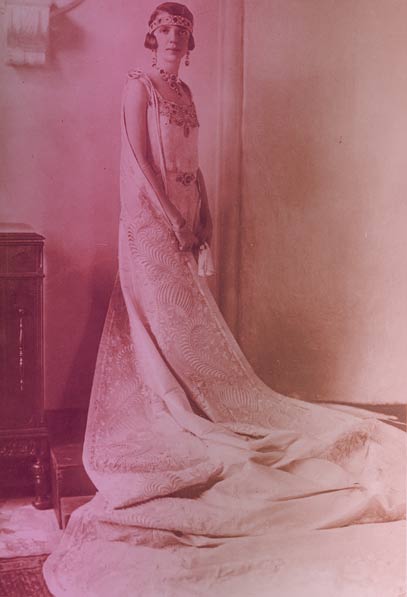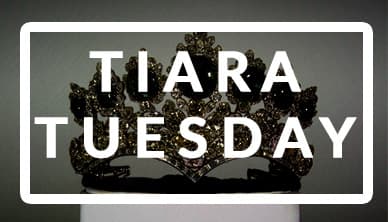Share this Post
Table of Contents
Intro | Before the Storm | The War | The Set-Up | To Buchenwald | The Attack | Aftermath | Mafalda’s Family
I came across this story while researching a post for Tiara Tuesday. And now that I know it, I can’t forget it, so I’m going to share it with you. It’s about Mafalda of Savoy, an Italian princess who died in a concentration camp during World War II.
Before the Storm

Princess Mafalda of Savoy was born in Rome in 1902. She had one brother and three sisters: Umberto, Yolanda, Giovanna, and Maria Francesca. Mafalda inherited a love of music and the arts from her mother, Queen Elena, who wrote poetry in her spare time. In 1925, Mafalda married a German prince, Philipp of Hesse. Between 1926 and 1940, the couple had 4 kids: Moritz, Heinrich, Otto, and Elisabeth.
When World War II broke out, Italy’s Fascist prime minister, Mussolini, sided with Germany and the rest of the Axis powers against France, Britain, and Russia. At first, this didn’t present a problem for Mafalda – after all, she’d married Prince Philipp of Hesse, a German prince and member of the Nazi party.
But it was a problem for Hitler because he freaking hated Mafalda.
Even though her husband was an intermediary between the German Nazi party and the Italian Fascists under Mussolini, he called her the “blackest carrion in the Italian royal house.” He wasn’t alone. Goebbels referred to Mafalda in his diary as “the worst bitch in the entire Italian royal house.”
Goebbels referred to Mafalda in his diary as “the worst bitch in the entire Italian royal house.”
They both believed she was working against them. Why? I’m not sure. Mafalda wasn’t generally interested in politics. She’d always been a happy, gentle girl. As a child, she’d been so frail that her mother used to weigh her almost daily to make sure she’d gained weight. Mafalda knew this and hid coins in her clothing to make it look like she was gaining weight. It worked until a few coins fell out one day – and the jig was up, as they say.
Does this little girl strike you as the type who would grow up to be feared by the leadership of the Third Reich? Me neither…but that’s what happened.
The War

Almost immediately, the war went south for Italy. It didn’t take Victor Emmanuel long to lose confidence in Mussolini. By mid-1943, he’d made up his mind to kick him to the curb. On the night of July 25, he met with Mussolini and issued his arrest warrant. However, they still had to avoid pissing Hitler off, so they pretended to remain staunch Axis allies. In private, though, members of the royal family had already reached out to Allies to ask for a separate peace. They announced that peace on September 8, 1943, which made Victor Emmanuel persona non grata with Hitler.
The king and queen got the hell out of Dodge just after the announcement was made.
There was just one problem.
Mafalda wasn’t with them.
She was in Bulgaria consoling her sister, Giovanna, after the sudden death of Giovanna’s husband, Tsar Boris III (who maybe was poisoned by Hitler, who knows – that’s another story).
Mafalda was in Bulgaria consoling her sister after the sudden death of her husband, Tsar Boris III (who maybe was poisoned by Hitler, who knows – that’s another story).
When Mafalda heard about the separate peace, she must have freaked out. What would happen to her family? To her country? She had no idea the Nazis had already arrested her husband – she thought he was safe in German, along with their oldest son. Her mom, Queen Elena, had sent her three youngest kids with a courtier to the Vatican, for safe keeping. Mafalda’s only goal was to get back to her children, no matter what.
The Set-Up
The Nazis tracked her every move. They watched her leave Bulgaria. They watched her train stop in Budapest. They watched her catch a plane to Italy, then take a train up to Rome.
When she got home, she learned that the rest of her family had already fled south to Brindisi. Her sons were indeed safe at the Vatican, where her mom had left them. When she finally got there, her son Enrico later wrote, “I had never seen her so thin and worn out…an infinite joy radiated from her tired eyes for having found us again.” But she still needed to make contact with her husband, so she left the kids at the Vatican and told them she’d be back tomorrow morning.
But early the next morning, the German police commissioner in Rome called her. He said he had an important message for her from her husband, Prince Philipp, and would she please come to the German embassy in Rome to receive it.
She went.
But the Nazis never let her go.
They arrested her on the charge of not informing them of Italy’s separate peace as soon as she knew about it. Since she was a German citizen through her marriage, they told her this was her duty.
To Buchenwald
The Nazis shipped her to Berlin for questioning. Then they shipped her to Buchenwald, largely in retribution for her father’s perceived treachery. They called her Frau von Weber, although several Italian prisoners recognized her as Princess Mafalda.
At Buchenwald, she lived in an isolated barracks (shack number 15) next to the ammunition factory on site, along with the former chairman of the SPD Reichstag group and his wife. An open trench next to the barracks was the only protection during the increasingly frequent air raids. If bombs started falling, their only recourse was to dive into the open trench and hope for the best.
While in the camp, Mafalda barely ate. Her weight dropped to 99 pounds, and kept decreasing. She was served the same food the SS officers ate, but her health had always been fragile. The food gave her digestion problems, so she gave most of hers to other prisoners.
The Attack
On August 24, 1944, Allied bombers attacked Buchenwald’s ammunition factory. Mafalda and the other cabin inmates hid in the trench. When bombs demolished the cabin, it fell over the trench. They found her alive, crushed under a pile of rubble. One side of her face was burned and her left arm was crushed and burned. In the aftermath, she recognized two fellow Italian prisoners by the “I” they wore on their shirts. She waved them over with her right arm. When they pulled her from the rubble, she said, “I’m dying. Remember me not as a princess but as your Italian sister.”
When they pulled her from the rubble, she said, “I’m dying. Remember me not as a princess but as your Italian sister.”
They brought her to the on-site brothel, which doubled as an infirmary.
After a couple days of agony, her arm became gangrenous. On August 26, a fellow prisoner, a surgeon, begged the SS hospital director to operate. He waited two more days – headquarters hadn’t approved it yet. When those orders finally arrived on August 28, the SS hospital director performed an excruciatingly slow amputation. He offered no post-op care or support. He simply left Mafalda in the infirmary, unconscious.
Sometime that night, Mafalda bled out and passed away. A radiologist named Pecorari, also interned at Buchenwald, believes they held off on treating her intentionally. Letting inconvenient political prisoners die on the operating table was the Nazis’ elegant solution for people too important to kill.
Aftermath

After the air raid, they tossed her body on a pile of corpses. A priest recognized her, smuggled her body out, and placed it in a wooden coffin. Coffin #262 was buried in nearby Weimar, with no name and no ceremony. After liberation in 1945, Dr. Pecorari found her burial site and etched her name on the back of her marker. Years after the war, in 1951, her coffin was removed. Now, Mafalda is buried with her husband’s family in Kronberg Castle in Hesse.
After the war, American military police took German citizens through the camp so they could see what happened there. The SS hospital director who treated Mafalda (and let her bleed out) had also experimented with “serums” on living people, who died 90% of the time. He was hanged after the war.
Mafalda’s Family
Before the war ended, the Nazis transferred her husband, Phillip, to Dachau. American soldiers eventually arrested him when they liberated the camps. After he served his sentence, he became an interior designer and lived out his life in Rome until his death in 1980.
Mafalda’s granddaughter, also named Mafalda, is a fashion designer.
Later, an Italian interned at Buchenwald said, “The only beams of light in Buchenwald were Mafalda’s eyes.” He never even spoke to her or touched her. He only saw her come and go from her shack.
Something about this story just won’t leave me alone. I wish I had the time to write about her. Maybe I’ll have to make time. This is one of those stories that never goes away once you let it in.
What do you guys think about this story? What does it make you feel?
Image credits
Mafalda and children: Unknown photographer, public domain via Wikimedia Commons
Mafalda as a child: Public domain via Wikimedia Commons
Mafalda as an adult: Photobucket, posted by Alexandre64_2007
Mafalda’s commemorative stamp: Laziowiki.org

Love Royalty and Tiaras?
You might like my other site, The Girl in the Tiara. I created it to write about amazing royal women and their tiaras. It’s like Drunk History meets The Crown.

Tiara Tuesday Archives
Visit the archives to read about more royal shenanigans. And by shenanigans, I mean war, revolution, betrayal, lust, murder, diamonds, and Princess Stéphanie’s chafing dish.
Share this Post
